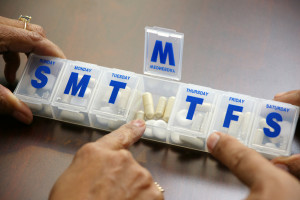It’s Spring Cleaning Time! Is Medication Management Included?

Yes, it’s time for annual spring cleaning, and what better place to start than your medicine cabinet? April is a great time to update your medication list, review your medication management program, and rid your home of expired medications and no-longer used prescriptions.
Most people don’t see the harm in taking a medication that is slightly out of date, assuming that the drug will still have some effect on their current ailment. And if it’s a bottle of aspirin that expired a month ago, they’re probably right. But here are just some of the problems with keeping expired medications around the home:
- Some medications undergo chemical changes over time, which may actually make them dangerous. The problem is that no one really knows what happens to drugs over time, so there’s no real way to know. Better to be safe and throw them out.
- Expired medications—which neither your doctor nor your pharmacist knows you’re taking—may produce harmful effects with other drugs you’re currently on. For instance, if you’re on a medication that has a side effect of lowering your blood pressure, and the expired medication has the same side effect, this could cause serious problems.
- If the medication is something that could potentially be life-saving, such as nitroglycerin or insulin, and you delay buying new medication because you still “have some left,” the medication may not perform the way it’s supposed to, with potentially dangerous results.
And while you’re at it, this is a good time to take an inventory of the drugs you’re taking—both prescription and over-the-counter. According to the Centers for Disease Control and Prevention’s report “Health, United States, 2013,” nearly half of all Americans take one or more prescription medications. By the time a person reaches age 65, that number reaches nearly 90 percent. The more drugs you take, the greater the chance of an adverse interaction. By taking charge of your medication management and sharing that information with your doctor or pharmacist, you lower the risk of a dangerous situation.
Finally, be sure to dispose of expired and no-longer-used medications safely. Find out if your community or pharmacist has a drug take-back program. The U.S. Drug Enforcement Administration (DEA) periodically holds a drug take-back day; the next event is scheduled for April 30, 2016. Visit the Office of Diversion Control’s National Take-Back Initiative web page to see if there’s a convenient location where you can dispose of any unwanted drugs you find during your medicine chest spring cleaning. During the last Take-Back Day, consumers turned in more than 350 tons of unused, expired or unwanted drugs!
The U.S. Food and Drug Administration and the Environmental Protection Agency DO NOT recommend that consumers flush medications down the toilet, as this can have harmful effects on our ecosystem. So if a take-back program is not readily available, take the unwanted medication out of its container, put it in a sealable bag or disposable container and put in the trash. The DEA suggests mixing pills with coffee grounds or kitty litter to make them undesirable to substance abusers. Remove any personal/private information from the pill bottle and place that in the trash as well.

